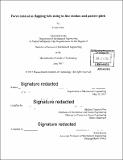Force control in flapping foils using in-line motion and passive pitch
Author(s)
Grant, Fiona (Fiona R.)
DownloadFull printable version (4.991Mb)
Other Contributors
Massachusetts Institute of Technology. Department of Mechanical Engineering.
Advisor
Michael Triantafyllou.
Terms of use
Metadata
Show full item recordAbstract
Flapping foils are the standard engineering approximation for many biological actuators in air and water, but these devices typically provide propulsion at the cost of parasitic oscillatory forces. The addition of in-line motion to a flapping foil trajectory can improve the control of the fluid force. Previous work has shown that by actuating the heave, surge, and pitch motions of a foil and iteratively optimizing the results, the lift and thrust forces on the foil can be precisely and independently controlled. In this thesis, the same experiment is modified to include solely passive pitch to determine if similar force control performance can be achieved without either a fully actuated pitch motion or an optimization process. In the new experiment, the fluid forces naturally drive the pitch motion for most of the flapping cycle, until the foil reaches a maximum pitch angle, which is set with a mechanical stopper. The hydrodynamic forces are recorded for a range of trajectories that include forwards in-line, backwards in-line, and no in-line motion. Lift force control improves over that of the fully actuated system, but thrust force control is not achieved to the same level of performance. Further work can be done to determine whether simple pitch angle control can be implemented to improve thrust force control without the addition of the optimization process.
Description
Thesis: S.B., Massachusetts Institute of Technology, Department of Mechanical Engineering, 2017. Cataloged from PDF version of thesis. Includes bibliographical references (page 39).
Date issued
2017Department
Massachusetts Institute of Technology. Department of Mechanical EngineeringPublisher
Massachusetts Institute of Technology
Keywords
Mechanical Engineering.